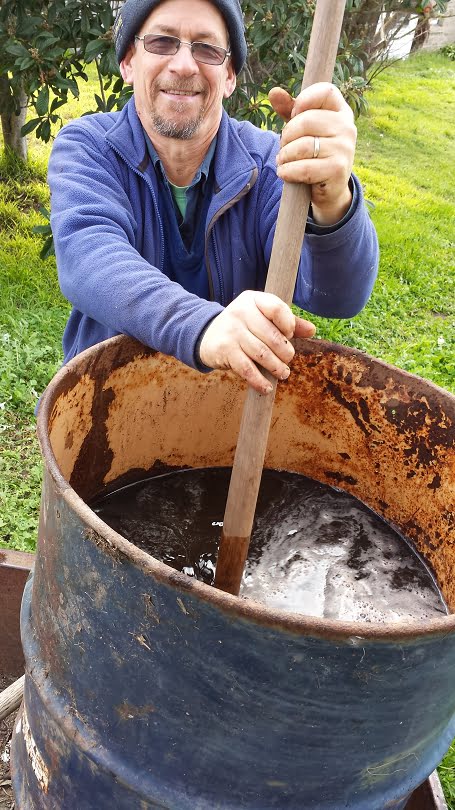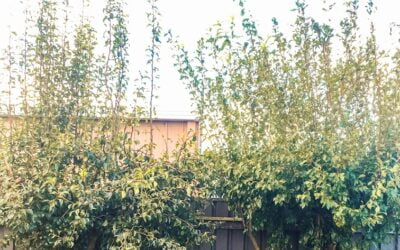Estimated reading time: 6 minutes
It’s nitty-gritty time! Time to get on the end of a shovel, dig a hole, and plant your fruit tree.
Let’s assume you’ve already planned your orchard and chosen the right site for your fruit trees. Of course, that might not be the case, and that’s fine too.
The most important thing is to get the trees in the ground this year and not put it off for another year — you can always move them later if need be!
Preparing the soil for planting fruit trees
If you’ve had a chance to prepare for planting, you might have done some soil preparation like planting a green manure crop or digging in some compost or manure. You may even have deep-ripped the site.
If you planted a green manure crop, ideally, you will have dug it back into the soil a week or two before you plan to plant your trees.
If not, it’s best to just cut and drop the plants on the surface of the ground, rather than dig in the green manure immediately prior to planting your tree.
The green manure can start to decompose quickly in the ground, which can create quite a bit of heat. This is not good for your young tree’s roots.
Don’t worry if you haven’t done any soil prep at all – it’s best to get the tree in the ground ASAP, and then work on the soil later.

Before you plant your tree
It’s great if you can dip the tree’s roots in an inoculant of some sort before you plant it. Dr Christine Jones recommends using a biostimulant such as worm juice.
This helps to populate the roots with lots of good microbes (e.g., bacteria and fungi). These microbes will help the tree get its nutrition as it grows.
A biostimulant also helps to kickstart important relationships between the roots of your fruit tree and other plants in the soil, which are essential for the good health of your fruit tree.

We often use compost tea as our biostimulant of choice. It’s also possible to buy ready-made inoculants, but they’re quite expensive and usually come in industrial quantities. Compost extract (compost soaked in water) or worm tea are fantastic, low-cost alternatives.
Next, dig a hole…
If you’ve done some soil preparation before you plant, the hole only needs to be big enough to accommodate the roots of your tree.
It’s completely fine to prune the roots back a bit to fit the hole or to remove any damaged roots.
The hole should be deep enough that when the tree is planted, it will be at the level it was in the nursery. This is often not as deep as you might imagine. If you look carefully at your tree, there will usually be a visible line on the trunk where the bark changes colour.

Planting the fruit tree
Once you’ve dug the hole, add any amendments that you’re using, and mix a bit of soil back in.
Now position the tree in the hole so it’s upright, and hold it while you back-fill a few shovels of soil over the roots. Make sure the soil fills the gaps between the roots, and then carefully but firmly tamp the soil down around the roots. Now finish back-filling the hole.
If drainage is an issue, mound the soil up a bit and plant into this. This ensures that any heavy rainfall will be able to drain away from the roots, especially if you’re planting your tree in heavy clay.
In most situations, you don’t need to water the tree after planting, unless you’re experiencing very dry soil conditions when you plant.
Do fruit trees need stakes?
We often see fruit trees tied to elaborate staking arrangements. We’ve planted thousands of fruit trees over the years, and have never staked them.
The trick is to plant them the right way, so they’re firmly embedded in the soil. There’s no need for stakes at all; your tree should be self-supporting.
And finally, prune your tree!

Planting is a pretty simple process. There are a few extra things to consider if you haven’t done any prior soil preparation or are planting into difficult soils. Heavy clay soil, very sandy soil, and weedy areas all pose their challenges.
New fruit trees are a great investment in your garden and your future food security. They will inevitably be the beginning of a journey of exploration as you get to know your new tree.
Over time, you’ll learn how the tree performs in the location you’ve chosen and your climate. And of course, the level of care you give it will be key!
Happy planting!
Related Articles
Taming monster fruit trees with renovation pruning
Learn how to use a technique called renovation pruning to tame large, unpruned, and out-of-control monster fruit trees.
How to buy a good fruit tree
Learn how to select a healthy fruit tree when you’re buying from a nursery, to give your trees the best possible start in life.
Know the parts of your fruit tree before you start pruning
Learning the different names for the parts of your fruit tree before you start pruning will help you to understand what you’re doing.








Hi I have a mulberry tree that is probably 3 feet high The problem is that it is too close to my robin is hedge. Can you tell me when would be the best time to move it. I appreciate any help that is given.
Hi Sharmaine, we’d usually recommend moving a tree when it is most dormant. So – if it’s winter where you are, that’s probably now! Good luck, Meg – Grow Great Fruit Team.
Hi, can you tell me how I should feed my blueberry trees that I planted last summer, and what care I should give them at this time in Melbourne?
Hi Sopo, a key thing for feeding your blueberries is to consider the pH of your soil. If they’re growing in the ground, it could be worth getting a pH test kit and testing your soil before you decide to add any amendments and which ones. The other thing to be aware of is that blueberries (and other plants in the ericacae family) dislike alkaline soils. Common garden amendments, such as using lime, can really interfere with blueberries because of this. To get your soil to a good pH for blueberries organically, adding composted manures and anything iron rich (e.g. composted animal remains) can help. Hope that helps – Meg, GGF team.
I have a grape vines when I planted them I had a few grape then I pruned last year I had nothing what have I done wrong? Thanks
Hi Jeannie,
Grape vines tend to fruit on one year wood, so it could be possible that the timing of the pruning removed the one year wood? Generally a good cut back in winter shouldn’t reduce fruiting. Hope you get some fruit this summer! Meg – GGF team.